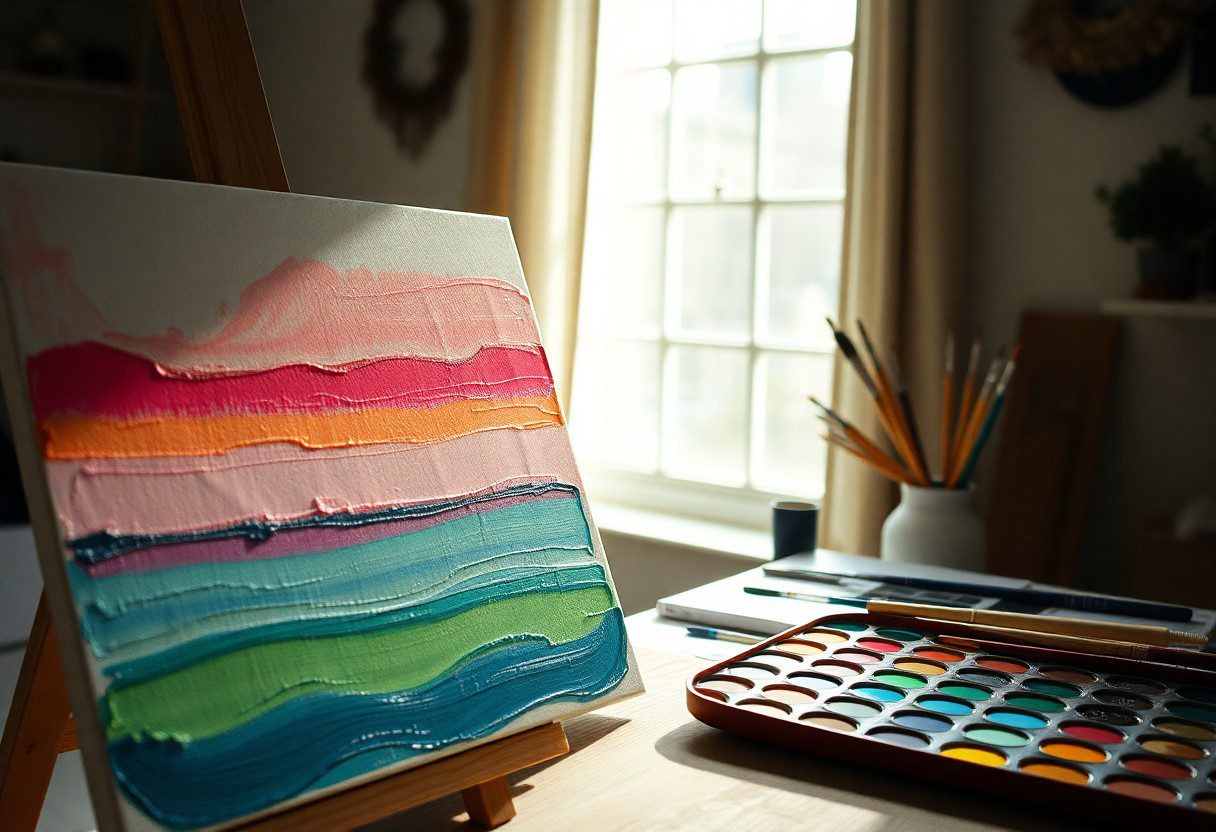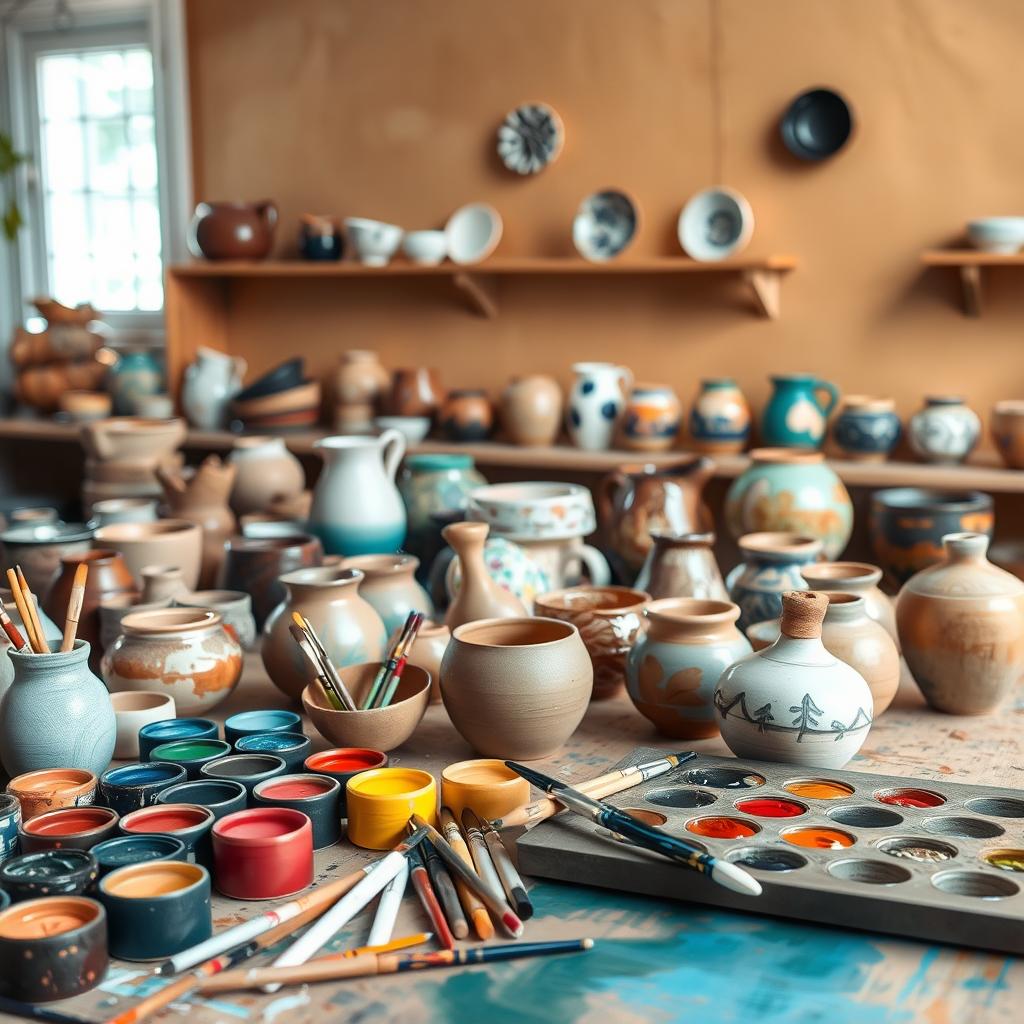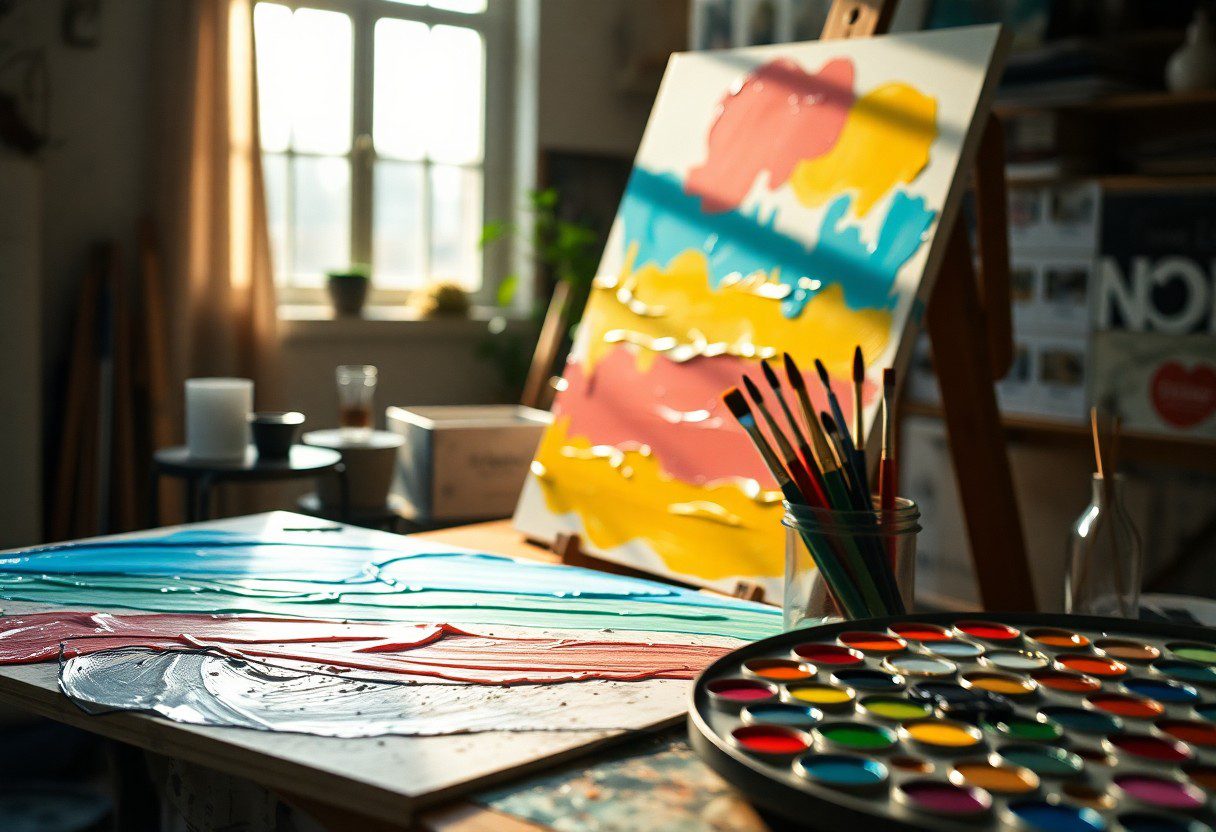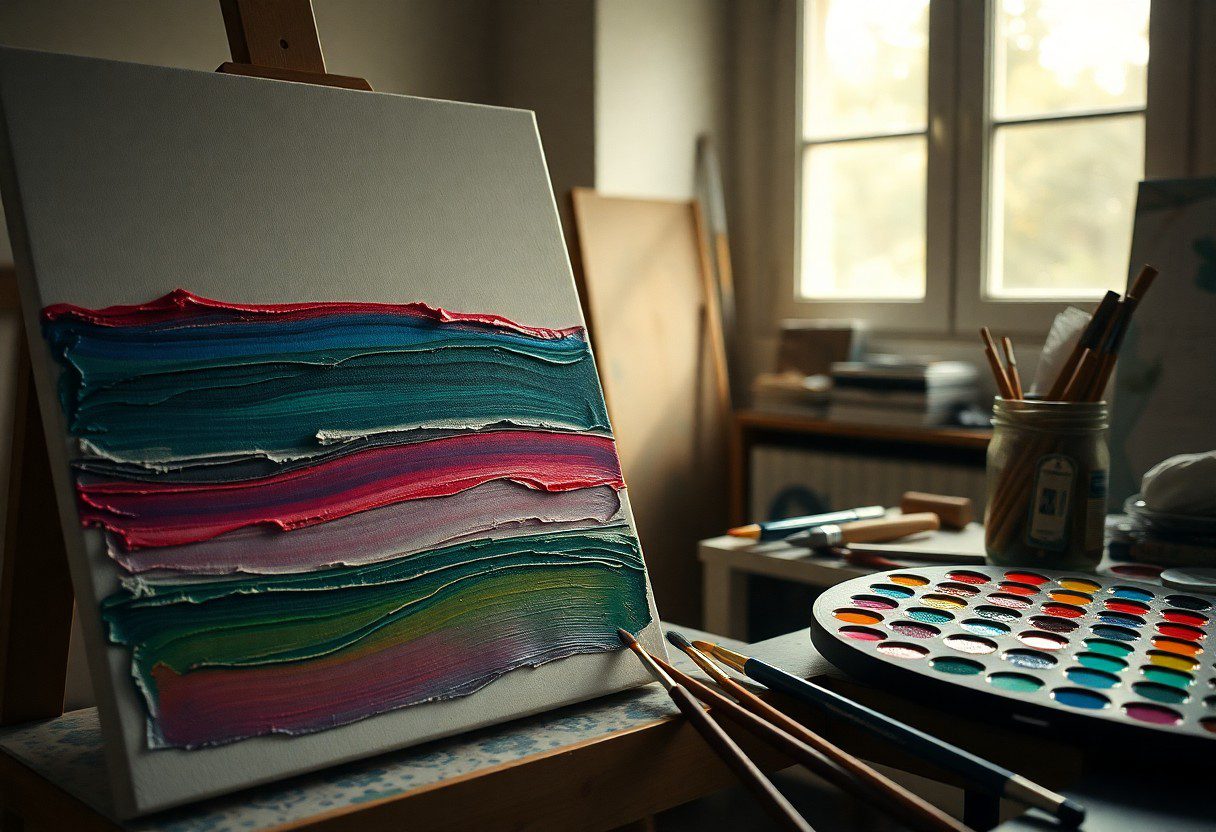You can elevate your acrylic paintings by mastering the art of layering paint. This technique not only adds depth but also enriches your artwork with vibrant colors and textures. In this guide, you will discover necessary tips that will help you achieve beautiful layers, avoiding common pitfalls that can lead to muddy results. By understanding transparency and application methods, you’ll learn how to create stunning effects and a professional finish in your artwork. Let’s probe the world of layering and transform your paintings into captivating masterpieces!
Understanding Acrylic Paint
While acrylic paint is a versatile medium that dries quickly and allows for vibrant colors, it also has a plastic-like finish that can affect your layering techniques. It can be thinned with water or mediums, enabling you to experiment with transparency and texture. Understanding its properties, such as drying time and mixing abilities, will significantly enhance your painting experience and allow for greater depth in your artwork.
Types of Acrylic Paint
Even the variety of acrylic paint available today can influence your creative approach. Here are some common types:
| Heavy Body | Thick and textured, great for impasto techniques. |
| Fluid Acrylic | Ideal for glazing and wash techniques. |
| Acrylic Gouache | Opaque, matte finish suitable for detailed work. |
| Student-Grade | Less costly, often with lower pigment concentration. |
| High-Intensity Acrylic | Exceptional vibrancy, perfect for bright designs. |
Perceiving the distinct characteristics of each type will help you select the right medium for your project.
Choosing the Right Brushes
Brushes are just as important as paint in achieving the desired depth and texture in your artwork. With so many options available, you may feel overwhelmed. Focus on selecting a few key brush types, such as flat brushes for broad strokes, round brushes for detail, and fan brushes for texture. Each shape can contribute to layering and blending in your acrylic work.
Paint with the right brushes can transform your paintings from simple to spectacular. You should use synthetic brushes for acrylic, as they retain their shape and stiffness. Pay attention to the size and shape of the brush, as finer brushes work well for details while larger ones are perfect for broad strokes. Avoid using natural bristle brushes, as they may absorb too much water and lose stability. Furthermore, invest in good-quality brushes, as they will not only last longer but also provide better control over your strokes and details.
Preparing Your Canvas
Any successful painting begins with proper canvas preparation. Before you investigate layering your acrylics, ensure your canvas is clean and free from dust or oils. Using a tight, smooth canvas will provide a solid foundation for your paint and enable better adhesion, allowing your artwork to thrive. Proper preparation can enhance your overall painting experience and yield professional results.
Priming Techniques
Techniques for priming your canvas can significantly impact your painting’s outcome. Start by applying a layer of acrylic gesso to create an even surface that enhances paint adherence and brightness. You can either use a brush or a roller, ensuring a smooth application. For better effects, consider adding multiple layers of gesso, allowing each coat to dry completely before adding the next.
Optimal Surface Choices
For optimal surface choices, you should consider the type of canvas or board that suits your style and technique. Canvas panels, stretched canvas, and acrylic paper are excellent options, providing different textures and absorbencies that can influence your work.
To achieve the best results, choose surfaces that complement your painting style. Stretched canvases are ideal for traditional acrylic techniques, offering a flexible and durable surface. Acrylic paper is great for experimenting with mixed media, while canvas boards provide a sturdy foundation for detailed work. Ensure the surface you select is pre-primed or prepare it with gesso to protect against paint absorption, promoting vibrant color application and preventing peeling.
The Importance of Color Theory
Some artists underestimate the power of color theory, yet it is fundamental to creating depth in your acrylic paintings. By understanding how colors interact, you can enhance the emotional impact of your artwork and guide the viewer’s eye. Knowing the relationships between colors allows you to construct a more cohesive piece that captivates and intrigues.
Warm vs. Cool Colors
Even within the basic color wheel, warm and cool colors play distinct roles in establishing mood and depth. Warm colors, like reds and yellows, tend to advance, pulling elements forward in your composition, while cool colors, such as blues and greens, recede, creating a sense of space. Mastering this balance is vital for achieving dimensionality in your designs.
Understanding Color Mixing
On your journey to mastering acrylic painting, understanding color mixing is vital. Knowing how to combine colors effectively enables you to create a broader palette and achieve the desired hue, saturation, and brightness in your artwork.
Another key aspect of color mixing involves recognizing how primary colors blend to form secondary colors, and how variations in mixing can yield remarkably diverse results. Mixing in layers can enhance the depth in your paintings, allowing colors to interact and create shadows and highlights that draw the eye in. Ensuring you have a good grasp of complementary and analogous colors will significantly improve your ability to create dynamic compositions. Don’t hesitate to experiment; it’s through trial and error that you will discover vibrant new mixes and techniques that define your unique style.
Layering Techniques
Keep in mind that mastering layering techniques can significantly enhance your acrylic paintings. By strategically applying multiple layers, you can achieve a sense of depth and complexity that draws viewers in. Whether you choose to incorporate glazing or impasto, each method serves a unique purpose in your artistic journey, allowing your creativity to shine brightly.
Glazing for Transparency
On your painting journey, glazing is a technique that allows you to create transparent layers of color over your dried paint. By mixing acrylic paint with a glazing medium, you can achieve a luminous effect, enhancing depth and vibrancy in your work. This method is especially effective for adding shadows or highlights without completely obscuring the underlying layers.
Impasto for Texture
Texture can elevate your painting by adding a tactile dimension that engages the viewer. To achieve impasto, you use thick layers of paint, applying them with a palette knife or your brush. This technique creates raised surfaces that catch light, bringing your work to life. Be mindful of the thickness, as too much heavy paint can crack as it dries, but the dramatic effects are well worth the risk when applied thoughtfully.
Factors Affecting Drying Time
Not all acrylic paints dry at the same rate due to various factors. Consider the following elements that influence drying time:
- Environmental Conditions
- Paint Thickness
- Humidity Levels
- Temperature
- Airflow
Any change in these factors can significantly impact how quickly your paint dries and how you can layer effectively.
Environmental Conditions
An ideal environment for acrylic painting includes moderate temperature and low humidity. High humidity can slow down drying times as water molecules linger in the paint, while excessive heat can cause the paint to dry too quickly, leading to unwanted textures.
Paint Thickness
Some artists prefer thicker layers of paint for added texture, but this can significantly affect drying times. Thicker applications retain moisture, which can prolong drying and impede your layering process.
With each application, be mindful that the thicker the paint, the more difficult it becomes to layer effectively. While chunky textures can enhance depth and interest, they also mean longer waiting times. Additionally, layers that dry too slowly may lead to a risk of smudging or lifting colors during your next application. Finding the right balance of thickness is imperative for a successful piece without compromising speed.
Tips for Achieving Depth
For a successful acrylic painting that conveys depth, you should consider the following tips:
- Utilize variations in color intensity
- Incorporate different brushstrokes for texture
- Apply glazes to create luminous layers
- Experiment with scale and perspective
- Use color temperature strategically
Recognizing how to manipulate these elements will significantly enhance the depth of your artwork.
Creating Contrast
While layering your acrylic paints, achieving contrast is necessary to add visual interest. You should strive to juxtapose light and dark colors, as well as warm and cool shades, to create dynamic compositions that guide the viewer’s eye.
Using Shadows and Highlights
Any effective painting utilizes shadows and highlights to enhance realism and depth. You can create depth by observing your subject closely and applying darker shades where shadows naturally occur while contrasting them with lighter tones in highlighted areas.
Creating shadows and highlights requires careful observation of light sources and surroundings. By applying darker colors in shaded regions, you add dimension, whereas using lighter colors on the surfaces that catch light creates a vibrant contrast. This relationship between light and shadow can significantly enhance your painting’s three-dimensional appearance, allowing your viewers to engage more deeply with the artwork. Ensuring a balanced approach between highlights and shadows will lead to a successful depth effect.
Final Words
Now that you have a clear understanding of how to layer paint, you can effectively enhance depth in your acrylic paintings. By choosing the right colors, mastering transparency, and allowing each layer to dry properly, you will create stunning visual effects that draw the viewer in. Experiment with different techniques and be patient with your process; the results will reflect your dedication and artistic growth. Embrace the journey and let your creativity flourish as you refine your layering skills!
FAQ
Q: What is the importance of layering in acrylic painting?
A: Layering is vital in acrylic painting as it adds depth, dimension, and richness to your artwork. By applying multiple translucent layers, you can create complex color interactions, enhance highlights and shadows, and build texture. This technique allows artists to achieve a sense of realism and improve the overall visual appeal of their paintings.
Q: How can I achieve smooth transitions between layers?
A: To achieve smooth transitions between layers, you can use a wet-on-wet technique or an addition of a medium that extends the drying time of the paint. Apply paint while the previous layer is still wet to allow colors to blend seamlessly or, if working with dry layers, use a soft brush to gently feather the edges between colors. Additionally, glazing can also help create smooth transitions by allowing light to pass through the layers, softening the edges.
Q: What are good practices for drying between layers?
A: It’s vital to allow adequate drying time between layers to prevent unwanted mixing. Use a fan or gentle airflow to speed up the drying process without disturbing your painting. Test the dryness by lightly touching an inconspicuous area. If the paint feels tacky, it’s not ready for another layer. Acrylics typically dry quickly, but environmental factors like humidity can affect this, so adjust accordingly.
Q: Can I use different mediums to enhance my layering technique?
A: Yes, various acrylic mediums can enhance your layering techniques. For instance, glazing medium allows you to create transparent layers without losing color vibrancy. Gel mediums can add texture and thickness, while matte or gloss mediums can finish your painting with different sheen levels. Experiment with these mediums to find the effects that best suit your artistic vision.
Q: How do I choose the right colors for layering?
A: Choosing the right colors for layering involves selecting a base color and a range of shades that complement or contrast effectively. Start with a mid-tone for your base and add lighter and darker colors for highlights and shadows. Consider using a color wheel to help identify harmonious combinations. Additionally, testing colors on a separate palette or paper before applying them to your painting can provide insights into how they will interact once layered.





